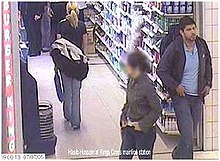This article needs additional citations for verification. (May 2021) |
Hasib Mir Hussain (Urdu: حسیب میر حسین; 16 September 1986 – 7 July 2005)[1] was one of four Islamist suicide bombers who detonated bombs on three trains on the London Underground and one bus in central London during the 7 July 2005 London bombings.
Hasib Hussain | |
|---|---|
 A CCTV image of Hasib Hussain leaving a Boots store on the King's Cross station concourse at 9 am on 7 July 2005 | |
| Born | Hasib Mir Hussain 16 September 1986 |
| Died | 7 July 2005 (aged 18) Tavistock Square, London, England |
| Cause of death | Suicide bombing |
Hussain detonated a bomb on the No. 30 bus that exploded in Tavistock Square, killing 13 of the 52 people killed in the suicide bombings, and himself. Investigators found his body and personal effects on the bus. At the age of 18, he was the youngest of the group of four. The other men were Shehzad Tanweer, Germaine Lindsay, and Mohammad Sidique Khan.
Biography edit
Hussain was born in Leeds General Infirmary and raised in Holbeck, West Yorkshire, Leeds, England, the youngest of four children. His father, Mahmood, of Pakistani origin, worked in a factory, while his mother, Maniza, was an interpreter for British Pakistani families at Leeds General Infirmary.
Hussain received his primary education at Ingram Road Primary School, Holbeck. In September 1998, he began his secondary education at South Leeds High School. Maintaining a good attendance record, he received GCSEs in English language, English literature, maths, science, Urdu, and design technology and a GNVQ in business studies in 2003. Hussain went on to attend Thomas Danby College in Leeds, earning a Vocational Certificate of Education (AVCE) in business the same year as the attacks. He was a member of the Holbeck Hornets football team and the local cricket team. When he left high school, teachers who knew him described him as "a slow gentle giant" who "did not spread leaflets of hate-mail".[2]
In the later half of 2003, Hussain met Mohammed Sidique Khan and Shehzad Tanweer. The three frequented the Stratford Street mosque in Beeston, and were also associated with the Hamara Youth Access Point, a drop-in centre for teens.
London bombings edit
There were media reports that Hussain had travelled to Pakistan in February 2004, but these appear to be a case of mistaken identity.[3]
In mid-June 2005, Magdi Asdi el-Nashar, an Egyptian lecturer at the University of Leeds, rented a flat from Dr. Adnan Shukir. Hussain played the role of el-Nashar's purportedly foreign friend. Sources differ, but either Hussain's brother or the police examined Hussain's mobile phone, which had Dr. Shukir's number in its storage. Police raided the flat, finding kilos of explosives and other evidence of a bomb-making operation.
Before Hussain went to London with Khan and Tanweer, all three men had travelled to 18 Alexandra Grove, Hyde Park, Leeds where the homemade explosive devices were assembled. The bombs were placed into a refrigerated box to maintain stability overnight. In the morning they travelled south towards Luton railway station, where they joined Germaine Lindsay, the fourth bomber, at around 7:20 am. They then made the trip towards King's Cross station.
On the day of the attacks, Hussain is believed to have intended to take the Northern line train. However, it was temporarily suspended on 7 July and so Hussain left the London Underground system. He was captured on CCTV in a Boots store on the concourse of King's Cross after the other bombs had gone off. Mobile phone records indicate that he had tried to telephone the other bombers. About 50 minutes after the other bombs had detonated, Hussain appears to have boarded the number 30 bus, his bomb exploding shortly thereafter: driving licence and credit cards were found in the wreckage of the bus in Tavistock Square.
Hussain's parents contacted Scotland Yard at about 10:20 pm on 7 July to report that their son had been travelling to London with three friends and had not been heard from since.
Hussain's body was buried in a Muslim cemetery in Leeds on 2 November 2005.[4]
References edit
- ^ Stokes, Paul (13 July 2005). "The teenager" – via www.telegraph.co.uk.
- ^ Rosser, Ian (20 July 2005). "'Slow, gentle giant' who blew up the No 30 bus and killed 13 others". Yorkshire Post. Retrieved 12 April 2009.
- ^ "UK boy wrongly labelled as bomber". BBC News Online. 21 July 2005. Retrieved 12 April 2009.
- ^ Patrick Mulchrone. "EXCLUSIVE: 7/7 SUICIDE BUS BOMB TEEN BURIED". mirror.co.uk. Retrieved 1 February 2022.